
Journal Entries:
Fall, 1943
![]()
At left is an image of the 9th Air Force patch worn by Billy and his comrades, the crews of the medium-range B-26 Marauder bombers
 |
Journal Entries:Fall, 1943
At left is an image of the 9th Air Force patch worn by Billy and his comrades, the crews of the medium-range B-26 Marauder bombers |
September 10 — England [1]
I now have three raids to my credit. Yes, three sweeps over enemy held territory. The first I made was on Sept. 5. Our target was the marshaling yards at Ghent Belgium. Our group (323) was to follow the 322nd in making a grand total of 72 ships. I was with Partridge and crew. We flew on Capt. Dave Sloane's right wing. We were in the second flight of a box of six led by Capt. M. E. Druhl. As we approached our landfall which was at Zeebrugge, Belgium, excitement in me was at its peak. I was acting as Nav-Bomb. and I was to toggle my bombs on the lead ship.
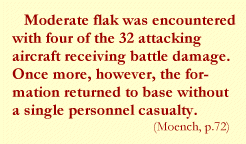 As we crossed the coast the Germans threw up some flak. There was quite a bit of it but we were using evasive action and none of the flak came close. It seemed a little unreal at first, those little black puffs of smoke. It was hard for me to realize that we were being shot at.
As we crossed the coast the Germans threw up some flak. There was quite a bit of it but we were using evasive action and none of the flak came close. It seemed a little unreal at first, those little black puffs of smoke. It was hard for me to realize that we were being shot at.
As we passed along the Netherlands border at 12000 ft. I could see Ghent off to our right. We reached our I.P. (initial point) and turned into the target. I was intent at my job. I must get my bombs away the first time. When the lead ship's fall mine must do the same. I check my control panel; all must be right. I had day-dreamed long ago about the day I would strike the first blow for victory, of how I would drop one for Norway and one for Austria, but as we started on the bomb run all that was forgotten. I was one man in about 432 with a job to do. My eyes were glued on the lead ship. His doors opened, mine opened, his bombs fell. I pressed the switch and said bombs away over inter-phone. 3,000 pounds of death and destruction fell from my plane with the slight movement of one of my fingers. I had done my job, my bombs were away. We returned with no losses.
My second raid was on the German airdrome of Lille-Nord just north of Lille, France on September the eighth [2]. I was navigator for Capt. M. E. Druhl and we followed Capt. Dave Sloane who led our box of six. We hit the airdrome and all ships returned safely.
 The third raid I made with Lt. N. D. Smith on Maj. Brier's left wing. We raided gun emplacements at Boulogne, France on the morning of the 9th of September. The flak was heavy and our evasive action was violent. We got our bombs away, whether they hit the target or not I don't know. The purpose of the raid on Boulogne was to cover amphibious practice by the Allies carried on in the channel.
The third raid I made with Lt. N. D. Smith on Maj. Brier's left wing. We raided gun emplacements at Boulogne, France on the morning of the 9th of September. The flak was heavy and our evasive action was violent. We got our bombs away, whether they hit the target or not I don't know. The purpose of the raid on Boulogne was to cover amphibious practice by the Allies carried on in the channel.
September 14 — England
On September 11 I made my fourth sortie over the channel. Our target was Beaumont le Roger Air Field near Le Havre, France. I flew with Capt. "Chuck" Enderton from the State of Washington. We were leading the high box of the first box of eighteen. We were being led by Capt. Grover Wilcox [3] of the lead box.
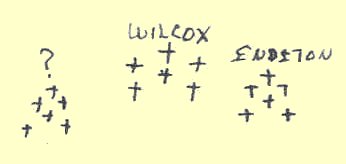
Since we weren't leading I left the pilot cockpit as we left the English coast and made my way to the ship's waist guns. I opened one door of the camera hatch, so that I might observe the bomb bursts. The Spitfires, bless their souls, were with us all the way. We entered the enemy coast at Fecamp and encountered no flak and we made our way across the Seine to our target, dumped our load of demos and frogs and made our turn to go out. We left the coast a few miles north of Fecamp. We smashed the target, but good.
We crossed the channel and turned north toward our base. As we were abeam of London we ran into soup, we climbed above it. At our e.t.a. we were still on top. The leader gave the landing signal and let down. Our box let down to the north and we broke out at about 500 ft. I gave the pilot a heading of 120° to the field; we flew for a short time when Enderton decided to get the Hell out of here. He asked for a heading to get us out. My judgement must have failed me. I gave him 200°. We hadn't been on 120° long enough to get us to the east. We could hear speakers and the pilot was rightfully worried about balloon barrages. I told him we would pass to the east of the ones at Chelmsford and soon the speakers died out. We circled one field to land but decided it was still too hazy; we took a heading of 190° this time and in 3 or 4 minutes we spotted balloons ahead. It was London; my course had been way off, we were heading for the balloon barrages at London. We circled to the right, sighted a field and landed. When we asked the operations officer the name of the place and it was then that we found out where we were—Hendon airfield north of London .
I had been lost in England for the first time. I hope it is the last.

September 28
On September 23rd, I made my fifth raid which was my Air Medal [4] mission. I rode with 1st Lt. Charles Boyer of Long Beach, California. Our target was Beauvais Tille airdrome in France. We went in with thirty-six ships and we were followed by another group of Marauders which made a total of seventy-two ships in our attacking force. We swept over the French coast and weather was good. We encountered no flak at the coast and along our route all was quiet except for a few dog fights here and there between Spitfires and enemy planes. We ran into quite a lot of flak over the target but no ships were hit. We unloaded our bombs and returned home without anything of interest happening.
 On September 27th I had my sixth sweep over the channel. It was a deep penetration for Marauders. Our target, the airdrome at Conches, France. We followed the 386th group in over the target and we ran into France with a large Spit escort. Those lovely Spits kept us safe from all attacks by enemy fighters. Over Bernay I saw one fighter go down. I couldn't tell what it was. We passed over our target and no flak was seen. As we swung off the target we were in behind the 386th. We passed close to Rouen on our way out. We were to leave enemy territory at a point ten miles west of St. Valery. The lead box of the 386 passed over the airdrome at St. Valery. They weren't doing evasive and the flak came up into their box and one B-26 went down in flames. We (our box of eighteen ships) were far to the right and we had only slight heavy flak. Capt. Enderton was my pilot and Capt. Wilcox of Anahuac, Texas, was leading our box.
On September 27th I had my sixth sweep over the channel. It was a deep penetration for Marauders. Our target, the airdrome at Conches, France. We followed the 386th group in over the target and we ran into France with a large Spit escort. Those lovely Spits kept us safe from all attacks by enemy fighters. Over Bernay I saw one fighter go down. I couldn't tell what it was. We passed over our target and no flak was seen. As we swung off the target we were in behind the 386th. We passed close to Rouen on our way out. We were to leave enemy territory at a point ten miles west of St. Valery. The lead box of the 386 passed over the airdrome at St. Valery. They weren't doing evasive and the flak came up into their box and one B-26 went down in flames. We (our box of eighteen ships) were far to the right and we had only slight heavy flak. Capt. Enderton was my pilot and Capt. Wilcox of Anahuac, Texas, was leading our box.
November 9 — England
On October 8 [5] we had an easy one, I guess number seven is my lucky number. Our target was an enemy airdrome near Lille, France. We made a normal climb on course, made our rendezvous with both bombers and fighters but as we started out over the channel we passed over an overcast. We remained on course until our E.T.A. for enemy territory was up. The Col. turned around and we brought our bombs home. Something very interesting happened after the mission: Capt. Frank Kapler (Group Nav.) turned in the combat report stating that we had crossed enemy territory. According to 8th Bomber Command Memo any time we crossed enemy territory we received credit for a mission. The Colonel was put out and said that we did not cross the French coast. Every navigator that made the flight was positive that we did but the Colonel said no! We received credit for the mission the next day when we found out that the other group had received credit for that particular mission.
On the 9th of October [5] we were still on the loading list because of the crossed opinions as to whether we were to receive credit for the mission the day before. Our target this day was Woensdrecht Airdrome in Holland. It was my eighth mission although I did not know it at the time. It was a clear day over Holland but the weather was a bit dreary from our side of the channel. There was a haze over the target area also. We missed our landfall over enemy territory a few miles but the Colonel was back on course soon after crossing the coastline. We picked up the target, made our run and dumped the eggs. The flak was heavy but slight. We were in the second box of eighteen led by Capt. Druhl.
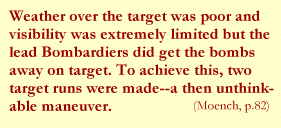 As we pulled away from the target we were surprised when the Colonel did not take his box out into the channel; he made a complete 360° and made a second run on the target. The flak was quite a bit more intense on the second run. The second box followed the Colonel around. We had a good look at Holland anyway and we did a pretty good job of bombing, also. The flak on the second run was not at all accurate.
As we pulled away from the target we were surprised when the Colonel did not take his box out into the channel; he made a complete 360° and made a second run on the target. The flak was quite a bit more intense on the second run. The second box followed the Colonel around. We had a good look at Holland anyway and we did a pretty good job of bombing, also. The flak on the second run was not at all accurate.
We were in the "Utah Game Cock," a "gas eater" on this trip and as we swept back across the channel our fuel supply was running low. We reached North Foreland and I got the time of the Landfall. As we turned toward the base we ran over an overcast. At the E.T.A. for base the lead box went thru the clouds. Capt. Druhl took the second box around once and then we started thru. Just as we broke out underneath the red light on our fuel gauge began to blink and my heart skipped a beat. The pilot looked at me as if to say "if you fail me this time" and he did say, "I want a heading back to the field and I want you to bring me right over it."
I gulped and said 180°. I knew 180° wouldn't bring us over the field but I thought that I would pick up a check point right away and then I could bring the ship right over.
We could see other ships still going north and he looked at me again and what a look. I knew what he was thinking. Will he fail me this time? Will we end up in the balloons this time for good? What have I got for a navigator? But he said, "Are you sure?"
I said with a nod, "Yeah." Could I be wrong?.... No, I must be right.
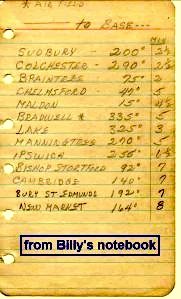 The pilot dipped his left wing and thru the haze I saw a small town and he asked me the name of it. I merely shook my head and all the time that red light was blinking in my eyes.
The pilot dipped his left wing and thru the haze I saw a small town and he asked me the name of it. I merely shook my head and all the time that red light was blinking in my eyes.
Enderton, the pilot, seemed to give up then and asked the radio operator for an A.D.M. I knew that would be useless, and somehow I knew, I just knew my heading was right: we were still north of the field.
We saw a landing field off to the left; we could set her down there, maybe I should tell the pilot to go over and set it down to give up my idea that my heading was right, and that is when it happened. I saw just over the nose two things that struck joy in my heart. Through the haze and mist I saw two church spires, yes two church spires, but they were two beautiful neon lights that pointed the way home. I said,
"Sudbury—200° now and we will be home in two minutes."
I could breathe again—home, and I was right.
November 12
That's all war is—a consuming fever: a period of delirium and insanity, of misery, disappointment, discomfort, anxiety, despair, waste, weariness, boredom, brutality, death: and yet to every man in every war there comes a day worth living for.
Kenneth Roberts, "Oliver Wiswell"
November 14 — England
On October 24 I was on number nine. Again I flew with Enderton. McAdams was bombardier. We (our group) went in with the 322nd, our thirty-six ships followed their force of the same number. We had Spitfire cover and an uneventful trip. Our target was an airdrome at Montdidier, France.
On November [6] the fifth we made a mystery raid on a secret target near Marquis, France. We were briefed on the target on the 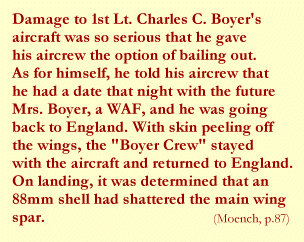 fourth, but weather held us on the ground all that day. We didn't know what Jerry had near Marquis that was so important to Bomber Command, but our orders were to get it and we did on the fifth. I was with Captain Wilcox on that sortie. We were leading a box of eighteen ships in behind Colonel Thatcher's lead box of eighteen. The haze was thick and it was with some difficulty that we made landfall at the French Coast. We swept to the north then past Boulogne to blast our target. McAdams the Bombardier did a beautiful job. As we pulled away from the target we ran into intense flak and our right wingman Charles Boyer (Long Beach) dropped out of formation with a large hole in his right wing. He made it back to base, however, and was recommended for the D.F.C.
fourth, but weather held us on the ground all that day. We didn't know what Jerry had near Marquis that was so important to Bomber Command, but our orders were to get it and we did on the fifth. I was with Captain Wilcox on that sortie. We were leading a box of eighteen ships in behind Colonel Thatcher's lead box of eighteen. The haze was thick and it was with some difficulty that we made landfall at the French Coast. We swept to the north then past Boulogne to blast our target. McAdams the Bombardier did a beautiful job. As we pulled away from the target we ran into intense flak and our right wingman Charles Boyer (Long Beach) dropped out of formation with a large hole in his right wing. He made it back to base, however, and was recommended for the D.F.C.
I wish I could describe the sound of flak bursting around the plane but as yet I can think of nothing that makes that sound. [7]
November 16 — England
Great men tell the truth and are never believed. Lesser men are always believed, but seldom have the brains or the courage to tell the truth.
Kenneth Robert,"Oliver Wiswell"
Since the September 11 raid on Beaumont and up until the raid at Marquis I had quite a time trusting myself. A feeling swept over me after our experience with the balloon barrages at London, a feeling of uneasiness. I'm sure that Enderton lost quite a bit of confidence in me as a result of that mistake I made. But the mission near Marquis and the two that followed helped to restore in me the confidence that I had in myself when I climbed down out of 1863 in Preswick after navigating across the Atlantic. Every navigator no matter how good he is, has been lost at one time or another I believe, but to get lost at a time when I did was bad. I was with a new pilot, new to me I mean, and it pays to be "on the ball," if I might use that worn out army phrase, the first few times with a new pilot. There were many days after that day that I felt rotten and I dreaded going up again because of that lack of confidence. On the mission to Marquis, I was in lead ship of second box and that trip started me on the road back to normal.
I made my eleventh mission on Nov. 10th. Our target was an airdrome at Chievres, France. We made landfall at the enemy coast at Furnes and followed another group inland to the target. The lead group missed the target because of the cloud cover, but our group, led by Major Brier spotted the target thru the clouds and made our run through a cloud of flak. Bombing was good and we returned without incident.
On Nov. 11, 1943, just twenty-five years after the signing of the armistice that ended the first half of the Great World War, I was on my twelfth raid. Our mission was to bomb target X near Martinvast, France. The target was excavations somewhat like the ones near Marquis. We carried two two-thousand pound bombs per ship. It was my first experience at leading my group. Capt. Heninger (Group Operations) took our crew and we led a group of eighteen ships of the 323rd down to Silsey Bill: there we joined another group and they took the lead and we swept out over the channel toward the
 Cherbourg peninsula.
Cherbourg peninsula.
We made landfall just due East of Valonges, which was our I.P. Clouds were very thick and there were but a very few holes. Our target was small and hard to see. We lined up our ship using the port of Cherbourg as a reference. Mac thought he saw the target and got it in the sight. We were too far left and we missed it completely.
We made a right turn and passed out over the sea and the[n] up between Aldernay Island and the mainland. Flak was intense at this point being fired from the island but we were at extreme range and were not hit.
Our mission was covered with R.A.F. Dominion and Allied Spitfires who always do a wonderful job.
December 26
On November 19 Bob Felt from Nebraska was leading B-Flight and I was riding with him. Our target was an airdrome at St. André, France. Maj. Pratt was leading the group and we were to make landfall at Fécamp, France near Le Havre. We missed our fighters in the channel and we were radioed to return to base. We did cross the coast however and the mission was counted. Number 13 was out of the way.
On November 23, B-Flight was off all but Mims and he was spare ship. I was standing by as his navigator and we were determined to get off and we were not disappointed in more ways than one. We saw quite a show. We thought that the sweep would be a milk run, but we were mistaken.
We made landfall at Hardelot, France and swept up to Samer and from that time until our bombs had hit their mark we were 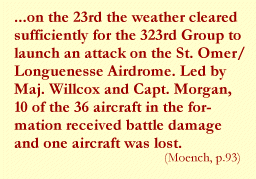 flying in a cloud of flak. Two Marauders were shot down, one in flames just to the left of our formations over the I.P. It was the second flamer I had seen and it isn't a pretty sight. I didn't see any shutes opening as the plane went down. The other 26 went down on our right. It was one of our group, but I didn't see it go down and I was glad that I did not.
flying in a cloud of flak. Two Marauders were shot down, one in flames just to the left of our formations over the I.P. It was the second flamer I had seen and it isn't a pretty sight. I didn't see any shutes opening as the plane went down. The other 26 went down on our right. It was one of our group, but I didn't see it go down and I was glad that I did not.
Major Wilcox was leading our group and he did a very good job. We went around all known flak areas on the way out and we were unhit.
Weather had closed in at our base and we had to divert to the B-17 base at Thurleigh near Cambridge and Bedford. We spent the night there and learned at first hand some shop talk about our big brothers, the forts.
On December 4 our target was again the airdrome at Chievre. I was riding with Enderton again and Major Pratt was leading. We made landfall at Nieuport [8] and we saw clouds banked high in the direction of our I.P. so Major Pratt made a left turn and we flew up toward Ghent to make our run from the north. We turned toward the target over a small village just south of Ghent. At E.T.A. for target we were over a cloud deck so we held our bombs and turned around and went back to base. As we passed out of Belgium we saw Ghent, Bruges and Ostend, really a sight-seeing tour. No losses were recorded as far as our bombers were concerned. We had a Spit escort, as usual.
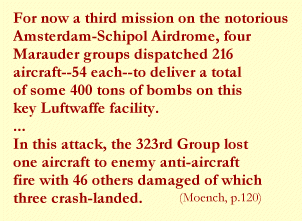 On December 5 our target was an X target near Crécy Forrest (These X targets that I have mentioned and will be mentioning in future write ups are believed to be emplacements for rockets and pilotless aircraft. We don't know too much about them as yet but we are now making an all-out effort to smash them.) [9] We were unable to find the target on Dec. 5 and we had to return to our base without having struck a blow at what might well be Nazi Germany's secret weapon.
On December 5 our target was an X target near Crécy Forrest (These X targets that I have mentioned and will be mentioning in future write ups are believed to be emplacements for rockets and pilotless aircraft. We don't know too much about them as yet but we are now making an all-out effort to smash them.) [9] We were unable to find the target on Dec. 5 and we had to return to our base without having struck a blow at what might well be Nazi Germany's secret weapon.
On December 13 there was a nervous combat group assembled in the crew room. Our target was an Airdrome, Amsterdam Schiphol, Holland, noted for its number of flak guns and the accuracy with which the gunners throw up the stuff. Our group had lost a ship over this target once before to say nothing of the damage inflicted to almost every ship.
We were to fly under Lt. Kahley (Iowa) in the high box of the lead box but Kahley had an engine cut out on him over the field 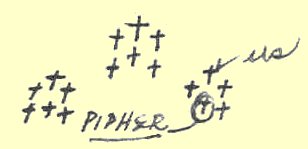 and we took the lead of the high squadron and the two remaining ships of Kahley's flight fell into formation under us.
and we took the lead of the high squadron and the two remaining ships of Kahley's flight fell into formation under us.
Around 400 marauders were hitting this airdrome that day in an all out effort to smash it for the winter. We attacked 36 ships at a time about ten minutes apart.
As we were sweeping along in mid-channel at 12,000 feet, we could see sunlight being reflected in the windows of some of the buildings at The Hague. We made landfall just north of The Hague and as we did we saw a cloud of flak at twelve o'clock and about thirty miles ahead and we knew that Marauders were catching Hell over Schiphol. It gave me a funny feeling in the pit of my stomach. The same feeling I get just before I sit in the dentist chair only worse.
As we reached the I.P. I could see our target to the left. The smoke from the flak that had been thrown up in a box barrage at the group ahead of us was still hanging in the air over the drome. As we turned on to the target and started our bomb run I had to swallow hard. The bomb bay doors of the lead ship opened then I opened mine. Major Gould was in the lead ship and he leveled out to give his bombardier a good run. The flak began to burst around us and it seemed that the lead ship would never
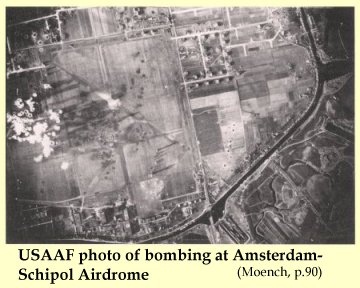 drop its load. Eternity passed on the run then finally the snow white bombs fell from the lead ship and mine went, too. I gave Chuck the heading away from the target as I closed our doors. Major Gould was hit and had to drop out of formation. Our formation was scattered and we were left wide open for fighter attack, but our Spit escort kept them off of us. A piece of flak came through the nose and pulverized the drift meter at my left elbow. I pulled my still helmet over my face to protect it from flying glass. We received another hit in the nose but it didn't come through.
drop its load. Eternity passed on the run then finally the snow white bombs fell from the lead ship and mine went, too. I gave Chuck the heading away from the target as I closed our doors. Major Gould was hit and had to drop out of formation. Our formation was scattered and we were left wide open for fighter attack, but our Spit escort kept them off of us. A piece of flak came through the nose and pulverized the drift meter at my left elbow. I pulled my still helmet over my face to protect it from flying glass. We received another hit in the nose but it didn't come through.
Lt. Pipher who was flying under us in our original position was shot down over the target. Several ships made crash landings when they got back to England. All ships received damage of some kind.
Flight Officer Robinson (Illinois) bailed his crew over England as his last good engine cut out on him. He left the ship at 500 feet on his first parachute jump. All in all it was an exciting show, but I hope I never see flak like that again.
The next three targets that brought my total number of raids to twenty were all on X targets. As I said before we are making an all out effort to knock out the vital targets. So far our luck has been bad mostly because of weather. On the 20th of December our
 target was an installation near the village of Vacqueriette in the Calais, Boulogne area, France. We made landfall over a cloud deck and had to return without dropping our bombs. On the return the weather that had been bad at takeoff had become worse and we had to divert. We landed south of London at the R.A.F. airdrome of West Malling near Maidstone. We landed on a steel mat and slipped and skidded to a stop. We dined here and returned to our base in the late afternoon.
target was an installation near the village of Vacqueriette in the Calais, Boulogne area, France. We made landfall over a cloud deck and had to return without dropping our bombs. On the return the weather that had been bad at takeoff had become worse and we had to divert. We landed south of London at the R.A.F. airdrome of West Malling near Maidstone. We landed on a steel mat and slipped and skidded to a stop. We dined here and returned to our base in the late afternoon.
On the 22nd our target was another similar target near the village of Yvrench near Crécy Forrest in the area near Abbieville, France. Major Wilcox flew with our crew on that day and we led the low squadron lead box. The weather was terrible between our base and the south of England. We swept south over the Thames estuary at 500 ft. The weather cleared a bit over North 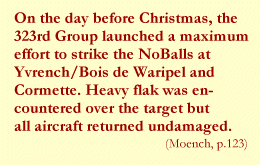 Foreland and we climbed up through the stuff at Gravesend to rendezvous with our bombers. Our box was separated from the lead box and we never did get into formation but the lead box turned back at landfall on the French coast and so did we. We returned to base again with our bombs.
Foreland and we climbed up through the stuff at Gravesend to rendezvous with our bombers. Our box was separated from the lead box and we never did get into formation but the lead box turned back at landfall on the French coast and so did we. We returned to base again with our bombs.
On the twenty-fourth our target again was Yvrench X target and we were lucky that day. We saw our target at the I.P. which was a railroad-river junction 8 miles south-east of Abbieville. We made a perfect run but we missed the target with the main pattern of bombs, but a few five hundred pounders hit pay dirt. We were covered by Spits and we passed out over Berck-sur-Mer without further incident.
Making peace is always more difficult than making war.
Lloyd Douglas-"The Robe"
December 30
With one day left in 1943 I made #21. We were to again attack no ball targets in the Crécy Forrest area. Our target was small as all the no balls are. It was located in a small wood about two and one half miles north-northeast of village of Yvrench.
Chuck Enderton was my pilot and we were leading the second box of eighteen ships in a seventy-two ship formation.
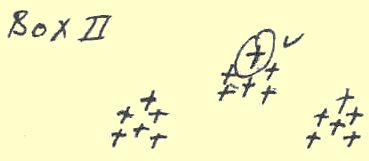
We made landfall at Ault and swept on into the I.P. which was a railroad junction ten miles south-east of Abbieville, France. We picked up our I.P. O.K. and we split our boxes, each was to proceed to its own target. As we turned on to our bomb run we saw the first box crossing our path and we had to do a 360 and try to pick up our target on a second run. We missed it completely on this run and it was under us before we saw it. We then decided to pick up our secondary target. My judgment was way off as we turned left just south of Hesdin Forrest and we missed this one, also. We were all sick and it was my fault. As we were losing our escort now due to their lack of range we were forced to return to our base with our bombs. It was our first chance at leading a box as a team—Chuck, Mac and myself—and we did and do feel rotten about missing it.
Display index of mission maps in a new window
Here is a picture of Billy and his crewmates with their plane, the Bird Dog Special, at some point after their 21st mission (note the number of bombs painted on the fuselage). The men in the picture are: back row—Ehalt (engineer), Hanson (tail-gunner), Schaffert (radio operator), Enderton (pilot); front row—McAdam (bombardier) and Billy. |
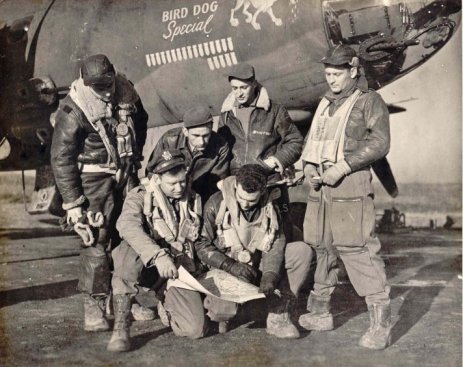 |
[1] Coincidentally, on the same date as this first Journal entry describing a combat mission, Andy Rooney, then a Stars and Stripes reporter, had an article about B-26 bomber crews published in the newspaper. Mrs. McKenna sent me a copy of the article, which is reproduced here.
[2] Billy wrote "ninth" here, which must have been a mistake; the date of this mission as the 8th is confirmed in Moench, p. 71.
[3] According to Moench, this man's name is spelled "Willcox," but it is spelled with only one "l" throughout the Journal.
[4] More information about the Air Medal and the citation Billy received when it was awarded.
[5] Here are another couple of mistakenly-written dates in the Journal; Billy wrote "October 7" and "8th of October" for these two missions, but Moench, p. 81, confirms the dates as the 8th and 9th.
[6] Billy wrote "October" here but that is an obvious error.
[7] One way of getting something of an idea of what flak looks and sounds like is to watch this newsreel video from the National Archives. The video includes some technical descriptions of how flak works. If this link is broken, you can look for it or similar videos on the National Archives YouTube channel.)
[8] The proper spelling for this Dutch town is "Nieuwpoort."
[9] More about "No Ball" targets.